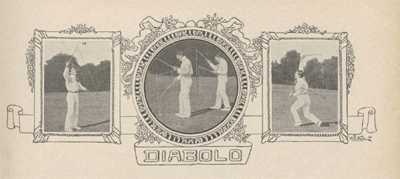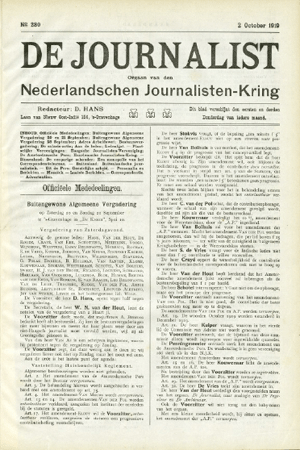TS. Tijdschrift voor tijdschriftstudies. Jaargang 2015
(2015)– [tijdschrift] TS–
[pagina 79]
| |
AbstractMost of the Dutch periodicals available on Delpher have been digitized with funding by Metamorfoze, the Dutch national programme for the preservation of paper heritage. Periodicals play an important part in the preservation strategy of the programme. In this TS Tools, we describe the history of Metamorfoze and its projects, consider the current course, and take a look into the future of the programme. | |
Keywordspreservation, Metamorfoze, periodicals, Dutch paper heritage
‘'T is een plaag scherp als een tweesnijdend zwaard...’ (‘It's a plague as a double-edged sword...’). In the early twentieth century, a new (or relatively new) invention took Europe and the United States by storm: the diabolo. Suddenly children and grown-ups everywhere were tossing and catching this two-sided cone-shaped toy. The popularity of the plaything, however, was not to everybody's liking, as can be deduced from the lamentations of a rather frustrated journalist in the Dutch sports magazine Op de Hoogte in 1907, who described the popularity of the new toy as a ‘plague’.Ga naar voetnoot1 Articles such as this one provide us with an unexpected insight into the interests and occupations of people from all walks of life. Indeed, periodicals, like newspapers, present a window on times past and present. | |
[pagina 80]
| |

Figure 1: photographic illustration of men in sports clothes playing with a diabolo, from: Op de hoogte (4), 1907, p. 807. Image: Koninklijke Bibliotheek.
To Metamorfoze, the Dutch national programme for the preservation of paper heritage, periodicals have always played a major role in its preservation strategy. The importance of periodicals as sources for cultural-historical research may seem self-evident. Nevertheless, as periodicals were generally thrown away after they had been read through, we are faced with the problem that many titles have not survived in complete sets. Furthermore, precisely because of their ephemeral nature, most periodicals - particularly those of the nineteenth and early twentieth centuries - were printed on cheap, low-quality and highly acidic paper. Therefore, preservation of those titles and issues that have survived is highly important. Throughout the first years of Metamorfoze, the originals of periodicals and other titles were preserved by means of microfilming and climate controlled storage; nowadays, originals are digitized. Metamorfoze initially focused on the preservation of Dutch paper heritage dating from the period 1840-1950. Paper of this period of production has the disadvantage that the autonomous decay of paper through acidification causes an acute problem today. In more recent years, Metamorfoze has expanded to include older paper archives, with material suffering from other forms of decay, such as ink corrosion. Metamorfoze aims at mass preservation and digitization of national paper heritage. Because of the scope of the programme, individual objects are only restored if the process of digitization requires this. | |
[pagina 81]
| |

Figure 2: cheap print in deplorable state. Image: Koninklijke Bibliotheek.
| |
PeriodicalsIn 2003, Metamorfoze set up a large-scale project aimed at the preservation of Dutch illustrated periodicals.Ga naar voetnoot2 This project involved the microfilming of forty popular nineteenth and twentieth-century periodicals with a running time of twenty-five years or more, a corpus that included many popular and culturally significant Dutch periodicals such as Panorama, De Lach, Libelle, and Kampioen. Issues from the collections of heritage institutions and publishing houses, as well as from private collections (and in some cases even issues that were found in dusty attics), were collected at the National Library of the Netherlands (the KB) and then microfilmed. Title runs were completed when possible. Unfortunately, these very important titles have still not been digitized, in spite of all the effort that has been put in finding as many issues as possible to ensure complete series. A second major project involving digitization, aimed at most frequently used periodicals, was set up in 2006. The title selection for this project was based on loan data from the KB (i.e. the most frequently requested titles), and on information provided by users (researchers, journalists, etc.) in a questionnaire. Those titles, eighty in total, form the basis of the current corpus of periodicals on Delpher. This corpus covers an immense variety of topics, ranging from law (Advocatenblad) to music (Caecilia), and from communism (De communistische gids) to sports (the Corinthian), to name but a few. In addition to these two large-scale projects, Metamorfoze has funded smaller projects by various Dutch heritage institutions for the preservation of periodicals about specific topics/themes. For example, in 2003, several Dutch heritage institutions cooperated in a project that aimed to preserve over thirty youth magazines. Some issues of these magazines have been digitized and made available on the website ‘Geheugen van Nederland’. In due time, these magazines will also be made available on Delpher. | |
[pagina 82]
| |

Figure 3: De Gracieuse, a digitization project in cooperation with the Gemeentemuseum The Hague. Digital images are available on www.geheugenvannederland.nl. Image: Gemeentemuseum The Hague.
Other projects have focussed on periodicals on architecture, Catholicism, journalism, advertising, and specific topics such as pilgrimage. While some of these periodicals are available on microfilm only, others have been digitized and are available at their parent institutions. However, as of yet, none of these periodicals have found their way onto Delpher. | |
[pagina 83]
| |

Figure 4: De Journalist, from the collection of the Persmuseum, Amsterdam.
An inventory of all Dutch digital library collections was recently published, the result of a national government funded project Bibliotheekcollecties in het netwerk (‘Library collections within the network’).Ga naar voetnoot3 This list provides an overview of all digital library collections available in the Netherlands, including books, newspapers, and periodicals. These digitized publications will eventually become available in the national digital infrastructure. | |
A new approachIn 2011, Metamorfoze set up a special route for the preservation and digitization of periodicals. The digitization of periodicals (as well as of other printed publications, such as books and newspapers, which have their own route) is coordinated and carried out by the KB. The KB collects all originals from the heritage institutions at the office in The Hague, where all periodicals are carefully checked and prepared. They are subsequently sent to a digitization company. All digitization companies working for Metamorfoze were selected by means of a European tender procedure. The digitization company produces a considerable number of digital files based on technical specifications formulated by | |
[pagina 84]
| |
Metamorfoze. All files are checked for completeness and correctness at the KB. At the end of the process, the originals are returned to the heritage institution, which also receives a complete set of the digital files. Almost seven hundred periodicals have been selected since the start of this route in 2011, making almost five million pages in all. The majority has already been digitized and will become available through Delpher in 2016. | |
SelectionFor the selection procedure and prioritization of titles, Metamorfoze has set up an advisory board consisting of six members, mainly researchers. Heritage institutions can submit one or more periodicals for review by this board twice a year. Since 2011, over forty Dutch heritage institutions have submitted one or more project proposals for the preservation and digitization of periodicals. These include leading institutions such as university libraries, the NIOD Institute for War, Holocaust and Genocide Studies, the National Library, the International Institute for Social Sciences (IISG), the Peace Palace in The Hague, but also small local or regional institutions, like the Lindenhout Orphanage Museum and the Dutch College for Obstetricians and Gynaecologists (NVOG). In 2014, Metamorfoze decided to prioritise the preservation of periodicals which treat of themes that have not received a lot of attention from the project in the past. In 2013, a survey showed that various types of periodicals had been widely covered by the Metamorfoze project, for example periodicals in the field of statistics or periodicals about religion and science. However, periodicals concerning other fields and subjects were hardly considered for digitalization. To address this lacuna, the advisory committee has decided upon seven major themes that form the framework for the selection and prioritization of titles: ‘Sport and recreation’, ‘Local and regional history’, ‘Child and youth’, ‘Art’, ‘Industry’, ‘Social societies’ and ‘Professions’. The last theme turned out to be especially popular with heritage institutions. Almost 48 per cent of the selected titles pertain to this theme. Far fewer proposals have been submitted for periodicals dealing with ‘Art’ and with ‘Local and regional history’. | |
[pagina 85]
| |

Figure 5: the front page of Revue der Sporten 1, 15 (1907). Image: Koninklijke Bibliotheek.
| |
The futureMetamorfoze will continue to be committed to the preservation and digitization of historical periodicals. The programme aims to play a more active role in the acquisition of new titles. Heritage institutions will be approached and requested to submit proposals for preservation of periodicals on specific themes. Metamorfoze recently expanded the publication period for periodicals that will be considered, changing it from 1840-1950 to 1840-1960. This means that new project proposals may now also include more recent issues. Furthermore, Metamorfoze also intends to digitize all titles which have previously been preserved only on microfilm. Finally, periodicals on Delpher can only be consulted at issue level at the moment. However, for most users and researchers it would be very useful to be able to consult periodicals at article level. Indeed, this is already possible for newspapers on Delpher. Metamorfoze considers making this option available for periodicals as well. In relation to this, we are also looking into the possibilities of crowd sourcing. The KB and the Meertens Institute for documentation of Dutch language and culture have recently initiated a crowd sourcing project in which volunteers transcribe historical Dutch newspapers and thus improve the OCR-processed texts. The quality of OCR-processed texts of periodicals could be similarly augmented. Over the last years, we have seen project proposals for many interesting and important periodicals by several heritage institutions, leading institutions as well as smaller ones. This interest shown by so many institutions, in combination with the | |
[pagina 86]
| |
continuously increasing number of proposals submitted, is a clear indication of the fact that over the next several years many more titles will be preserved and made available with Metamorfoze funding. This will eventually result in a vast corpus of digitized periodicals that can be consulted and fully searched on Delpher. •> Rubrecht Zaat works as project coordinator BKT for Metamorfoze. |
|

